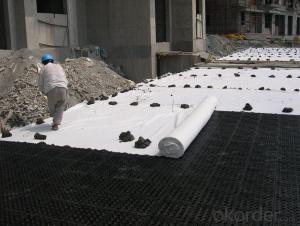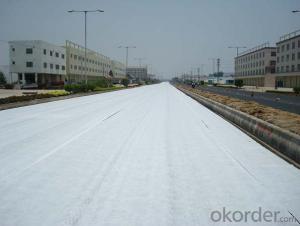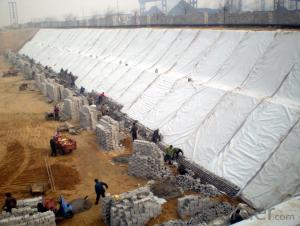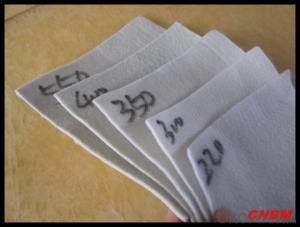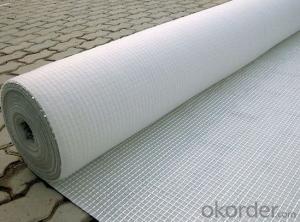High Strength Polyester Continuous Filament Nonwoven Geotextile
- Loading Port:
- Qingdao
- Payment Terms:
- TT or L/C
- Min Order Qty:
- 10000 m²
- Supply Capability:
- 100000 m²/month
OKorder Service Pledge
OKorder Financial Service
You Might Also Like
Polyester Continuous Filament Spunbonded Non Woven Geotextile
1. Description of Polyester Continous Filament Nonwoven Geotextile
CMAX continuous filament spunbonded non woven geotextile is made from ployester chips, the continuous filament was extruded from polyester chip by machine directly by spunbond process, and then punch together to get the stable 3D with higher strength fabric. So it has high strength, good creep property excellent and erosion resistance, aging-resistance and heat resistance.
2. Specification of Polyester Continous Filament Nonwoven Geotextile
Weight: 100gsm – 800gsm;
Width: 1m -7m; Length: as clients’ required.
3. Technical Data Sheet of Polyester Continous Filament Nonwoven Geotextile
Item | Unit | Index | |||||||||
Weight per Square Meter | g/m2 | 100 | 150 | 200 | 250 | 300 | 350 | 400 | 500 | 600 | 800 |
Thickness | Mm | 0.8 | 1.2 | 1.6 | 1.9 | 2.2 | 2.5 | 2.8 | 3.4 | 4.2 | 5.5 |
Breaking Strength | KN/m | 4.5 | 7.5 | 10 | 12.5 | 15 | 17.5 | 20.5 | 22.5 | 25 | 30 |
Elongation at Break | 40~80 | ||||||||||
CBR Mullen Burst Strength KN | KN | 0.8 | 1.4 | 1.8 | 2.2 | 2.6 | 3 | 3.5 | 4.7 | 5.5 | 7 |
Tear Strength | KN | 0.14 | 0.21 | 0.28 | 0.35 | 0.42 | 0.49 | 0.56 | 0.7 | 0.82 | 1.1 |
Seive Size O90 | Mm | 0.07~0.2 | |||||||||
4. Property of Polyester Continous Filament Nonwoven Geotextile
Good creep property and hydraulics property, resistance to corrosion, excellent anti-aging and heat resistance quality.
5. Application of Polyester Continous Filament Nonwoven Geotextile
1) Filtration of soils in drainage applications by retaining soil particles while allowing for the free flow of water.
2) Separation and reinforcement in road and railway construction.
3) Prevention of soil movement in erosion control measures.
4) Cushioning and protection in many containment projects.






FAQ of our geotextile:
- Q: What can we do for the special customer?
A: Provide custom made service with customer's drawing; We make sure to provide you with the best solutions for your individual case. Whether standard items or non-standard items.
- Q: What can we supply?
A: We provide high levels of communication from start to finish.
- Q: What is our advantage?
A: Top Cemented Carbide has extensive business experience, Fast delivery and high quality.
--Q: Do you have some suggestion when choosing geotextile?
A: Before going out to buy a geotextile fabric, you should determine exactly how much you need. Typically, it's best to lay down enough sheets to cover the whole surface area. Remember that these sheets are rolled up. While a single roll will correctly cover all of your project's length, you will need to use several rolls to cover the whole area. Also, it is a good rule of thumb to have about 15% of each sheet overlapping above the next sheet in order to prevent any holes or gaps in between. While small breaks or ruptures in the fabric aren't a big deal, you definitely want to avoid the formation of large holes because that allows room for weeds to grow through. And that defeats the whole purpose of using the geotextile fabric.
Another good thing to keep in mind is how dense you want the sheets to be. A denser layer means less water will be able to pass through and there will be less risk of having unwanted plants come through as well. However, this will cost more and may not be needed if you have soil that is already in good condition. You should consider and make your decision about this before you start researching the different types and prices.
Bottom Line
Overall, geotextile fabric is a great tool that you should use when doing landscaping and certain construction work. It can help you on many levels, such as preventing unwanted weeds and allowing proper water drainage. Just keep in mind the type of material you need, the quality and the number of rolls required and you'll be all set with your geotextile fabric needs.
- Q: What are the considerations for geotextile installation?
- Some considerations for geotextile installation include site preparation, proper anchoring techniques, selecting the appropriate geotextile material for the specific application, ensuring proper overlap and seam strength, and proper maintenance and inspection of the installed geotextile.
- Q: How do geotextiles improve the performance of geosynthetic tubes?
- Geotextiles improve the performance of geosynthetic tubes by enhancing their filtration and separation capabilities. They act as a barrier against soil particles, preventing clogging and promoting effective water drainage. Additionally, geotextiles provide reinforcement and stabilization to the geosynthetic tubes, increasing their strength and durability. This combination of filtration, separation, and reinforcement properties offered by geotextiles significantly enhances the overall performance of geosynthetic tubes in various geotechnical applications.
- Q: What are the key differences between woven and nonwoven geotextiles?
- Woven geotextiles are made by weaving individual threads together to create a strong and durable fabric, while nonwoven geotextiles are made by bonding fibers together using heat, chemicals, or mechanical processes. Woven geotextiles have high tensile strength and are commonly used for soil stabilization, erosion control, and separation of different soil layers. On the other hand, nonwoven geotextiles have excellent filtration and drainage properties, making them suitable for applications such as filtration, separation, and protection. Overall, the key differences between woven and nonwoven geotextiles lie in their manufacturing process, physical properties, and intended usage.
- Q: Artificial lake can not do geotextile waterproofing? What method can not do geotextile waterproof?
- Yes, with polyethylene polypropylene cloth is also OK
- Q: How do geotextiles contribute to the durability of civil engineering structures?
- Geotextiles contribute to the durability of civil engineering structures by providing reinforcement, filtration, and separation. They act as a barrier against soil erosion, increase the load-bearing capacity of soil, and offer protection against water seepage. These functions help to prevent structural damage, enhance the lifespan of the infrastructure, and ensure its long-term stability.
- Q: Can geotextiles be used in tunnel construction?
- Yes, geotextiles can be used in tunnel construction. Geotextiles are often used as a reinforcement material in underground structures like tunnels to provide stability, prevent soil erosion, and improve drainage. They can be used in various applications such as tunnel lining, separation of different soil layers, and filtration of water or gases. Geotextiles offer numerous benefits in tunnel construction, including increased safety, reduced maintenance, and enhanced durability.
- Q: How do geotextiles help with reinforcement of geosynthetic tubes?
- Geotextiles help with reinforcement of geosynthetic tubes by providing additional strength and stability. They act as a barrier between the soil and the tube, preventing soil erosion and maintaining the shape and integrity of the tube. The geotextile fabric also helps distribute the load evenly across the tube, preventing localized stress and potential failure. Additionally, geotextiles can improve filtration and drainage, allowing water to pass through while retaining the soil particles, thus enhancing the overall performance and longevity of the geosynthetic tube.
- Q: Where to sell geotextiles
- Those who produce geotextile manufacturers are selling black geotextile. Black geotextile according to the use of a lot of specifications, the price difference is very large. The weight per square meter between about 50-1000g grams, the weight of different unit price is different, the inquiry directly asked how much money per ton. According to the use of distinction between the current market price per ton price between 5,000 yuan - yuan. For the conservation, isolation, insulation of the geotextile the cheapest. In the 5000 yuan / ton between. For the filter, soft base treatment, slope protection, reinforced decoration, and other purposes of the black geotextile most expensive in - yuan / ton. The same black color, but different uses, production processes and production costs are not the same.
- Q: Are geotextiles biodegradable?
- No, geotextiles are not biodegradable.
- Q: Geotextile price
- If you want to consult the price of geotextile, (I do not know you want to filament geotextile or short wire geotextile), first of all to determine what you need is to achieve the national standard or non-standard, followed by the specifications you want, mainly per square meter Weight, there is a need to contact
1. Manufacturer Overview
| Location | Taian City,Shandong Province,China |
| Year Established | 2008 |
| Annual Output Value | Above US$100 Million |
| Main Markets | Africa, Oceania, North America, Western Europe, Eastern Asia |
| Company Certifications | ISO9001;IS014001 Certificate |
2. Manufacturer Certificates
| a) Certification Name | |
| Range | |
| Reference | |
| Validity Period |
3. Manufacturer Capability
| a) Trade Capacity | |
| Nearest Port | Qingdao Port;Tianjing Port;Shanghai Port |
| Export Percentage | |
| No.of Employees in Trade Department | 21-30 People |
| Language Spoken: | English; Chinese; |
| b) Factory Information | |
| Factory Size: | 10,000-30,000 square meters |
| No. of Production Lines | Above 10 |
| Contract Manufacturing | Geotechnical Material (Geogrid,Fiberglass/Polyester Geogrid,Geocell,Geonet and Geomat,Plastic Safety Fence) |
| Product Price Range | Average |
Send your message to us
High Strength Polyester Continuous Filament Nonwoven Geotextile
- Loading Port:
- Qingdao
- Payment Terms:
- TT or L/C
- Min Order Qty:
- 10000 m²
- Supply Capability:
- 100000 m²/month
OKorder Service Pledge
OKorder Financial Service
Similar products
Hot products
Hot Searches
Related keywords

